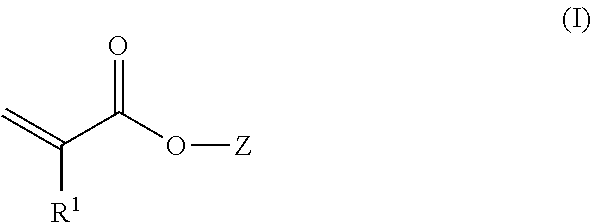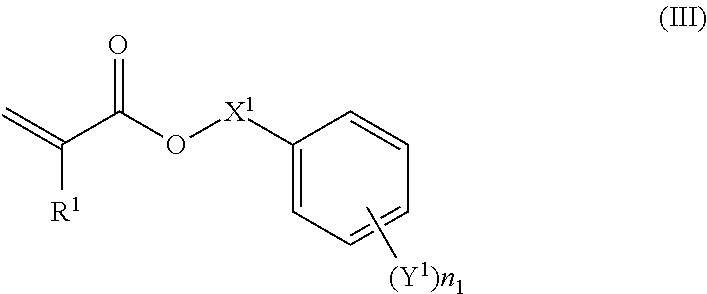Curable composition for imprints, patterning method and pattern
a composition and composition technology, applied in the field of curable composition for imprints, patterning methods and patterns, can solve the problems of so-called magnetic field expansion, cost reduction and throughput increase, and difficulty in satisfying all three of micropattern resolution, and achieve excellent dry etching resistance and good patternability
- Summary
- Abstract
- Description
- Claims
- Application Information
AI Technical Summary
Benefits of technology
Problems solved by technology
Method used
Image
Examples
example 1
Synthesis of R-1-1-R-1-7
[0248]Monofunctional acrylate monomers R-1-1-R-1-7 shown in the table below were synthesized by acrylizing alcohol as the precursor thereof and by purifying it with silica gel-column chromatography.
[0249]R-1-8: benzyl acrylate (Biscoat #160, manufactured by Osaka Organic Chemical Industry Ltd.)[0250]R-1-9: 2-ethylhexyl acrylate (manufactured by NIPPON SHOKUBAI)[0251]R-1-10: cyclohexylethyl acrylate (the alcohol as the precursor thereof was acrylized to synthesize it.)[0252]R-1-11: dicyclopentenyl acrylate (FANCRYL FA-513A, manufactured by Hitachi Chemical)
[0253]Molecular weight of the monomers was computed with CS Chem Draw Drawing.
[0254]The measurement of viscosity of the monomers R-1-1-R-1-7 was conducted at 25±0.2° C. using a RE-80 L-type rotational viscometer manufactured by Toki Sangyo Co., Ltd.
[0255]The measurement of the viscosity was conducted, respectively, by setting the rotation speed in the measurement at 100 rpm in the case of 0.5 mPa·s or more a...
example 1-1
[0279]The polymerizable monomer of R-1-1 (40% by mass), the polymerizable monomer of S-1 (30% by mass), the polymerizable monomer T-1 (30% by mass), the photopolymerization initiator of P-1 (0.5% by mass %, relative to the amount of the total amount of the polymerizable monomers), the antioxidant of A-1 (1.5% by mass, relative to the total amount of the polymerizable monomers), the antioxidant of A-2 (0.5% by mass, relative to the total amount of the polymerizable monomers), the surfactant of W-1-1 (0.1% by mass, relative to the total amount of the polymerizable monomers) and the surfactant of W-1-2 (0.04% by mass, relative to the total amount of the polymerizable monomers) were mixed to prepare the curable composition for imprints of Example 1-1.
(Curing with Photo Irradiation)
[0280]The compositions was applied onto a grass substrate in a mode of spin coating to obtain a coating film having a thickness of 3.0 micrometers. The spin-coating film was set to an imprinting device manufac...
examples 1-2 to 1-7
[0282]Each of curable compositions for imprints of Examples 1-2 to 1-7 as described in the table below was prepared. Each resist pattern was obtained by curing the composition with photo irradiation and with heat as the same method in Example 1-1.
PUM
| Property | Measurement | Unit |
|---|---|---|
| viscosity | aaaaa | aaaaa |
| viscosity | aaaaa | aaaaa |
| size | aaaaa | aaaaa |
Abstract
Description
Claims
Application Information
 Login to View More
Login to View More - R&D
- Intellectual Property
- Life Sciences
- Materials
- Tech Scout
- Unparalleled Data Quality
- Higher Quality Content
- 60% Fewer Hallucinations
Browse by: Latest US Patents, China's latest patents, Technical Efficacy Thesaurus, Application Domain, Technology Topic, Popular Technical Reports.
© 2025 PatSnap. All rights reserved.Legal|Privacy policy|Modern Slavery Act Transparency Statement|Sitemap|About US| Contact US: help@patsnap.com



